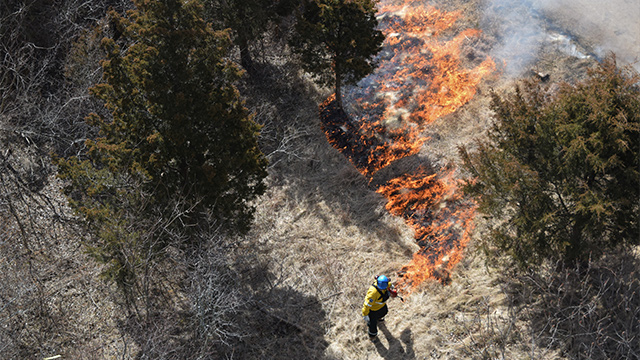
Use of prescribed fire
Point Pelee National Park
Controlled, intentionally lit fires are known as prescribed fires. Although Parks Canada had conducted prescribed fire at Point Pelee National Park historically, the prescribed fire program was revived in 2011 as an important part of the Lake Erie Sand Spit Savannah conservation and restoration project.

Prescribed fires reduce fuel to lessen the severity of wildfires, release nutrients, encourage native seed germination, and allow for a mosaic of ecosystems that support diverse plants and wildlife. For this reason, the prescribed fire program at Point Pelee National Park is an important part of the park’s Lake Erie Sand Spit Savannah restoration project. At Point Pelee National Park, prescribed, controlled fire in selected areas reduce the number of exotic plants and prevent the spread of invading shrubs and trees in savannah habitats. Since 2011, prescribed fire has revitalized approximately 16 hectares of land, restoring globally rare savannah habitat with open, sunny conditions that native plants and animals depend upon. This is an important step in restoring healthy, resilient ecosystems that support a variety of birds, butterflies, and other animals including many species at risk.
Prescribed fires are only conducted under suitable conditions; weather, moisture, wind direction, and supporting resources are all considered. Projects using prescribed fire will only go forward when the safety of the public, fire crews, park infrastructure and neighbouring lands can be assured. It is important to remember that the flora and fauna of Point Pelee National Park, including species at risk, have adapted to the presence of fire over millennia and depend upon fire to sustain the habitats they require to thrive.
To help ensure the optimal survival of species at risk during a prescribed fire, staff at Point Pelee National Park:
- Conduct prescribed fires during the winter and early spring months before birds start nesting, before reptiles are out of hibernation, and before native plants begin to bloom;
- Flag species at risk trees in advance to make sure they are identified and visible;
- Wet down species at risk such as prickly pear cactus and common hop tree ahead of the fire to provide additional protection; and
- Control fire spread rates and spread directions when working near species at risk.
- Date modified :